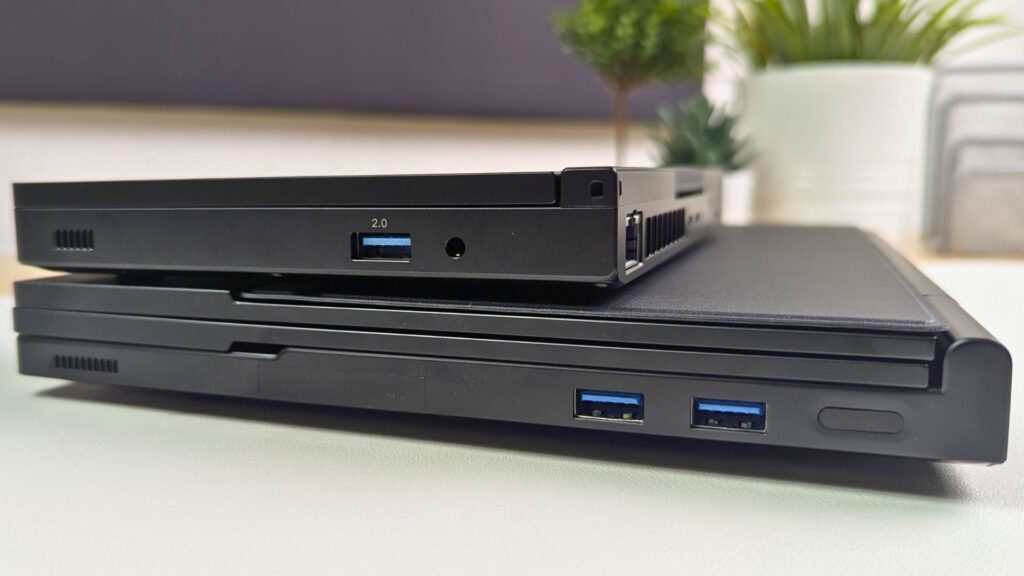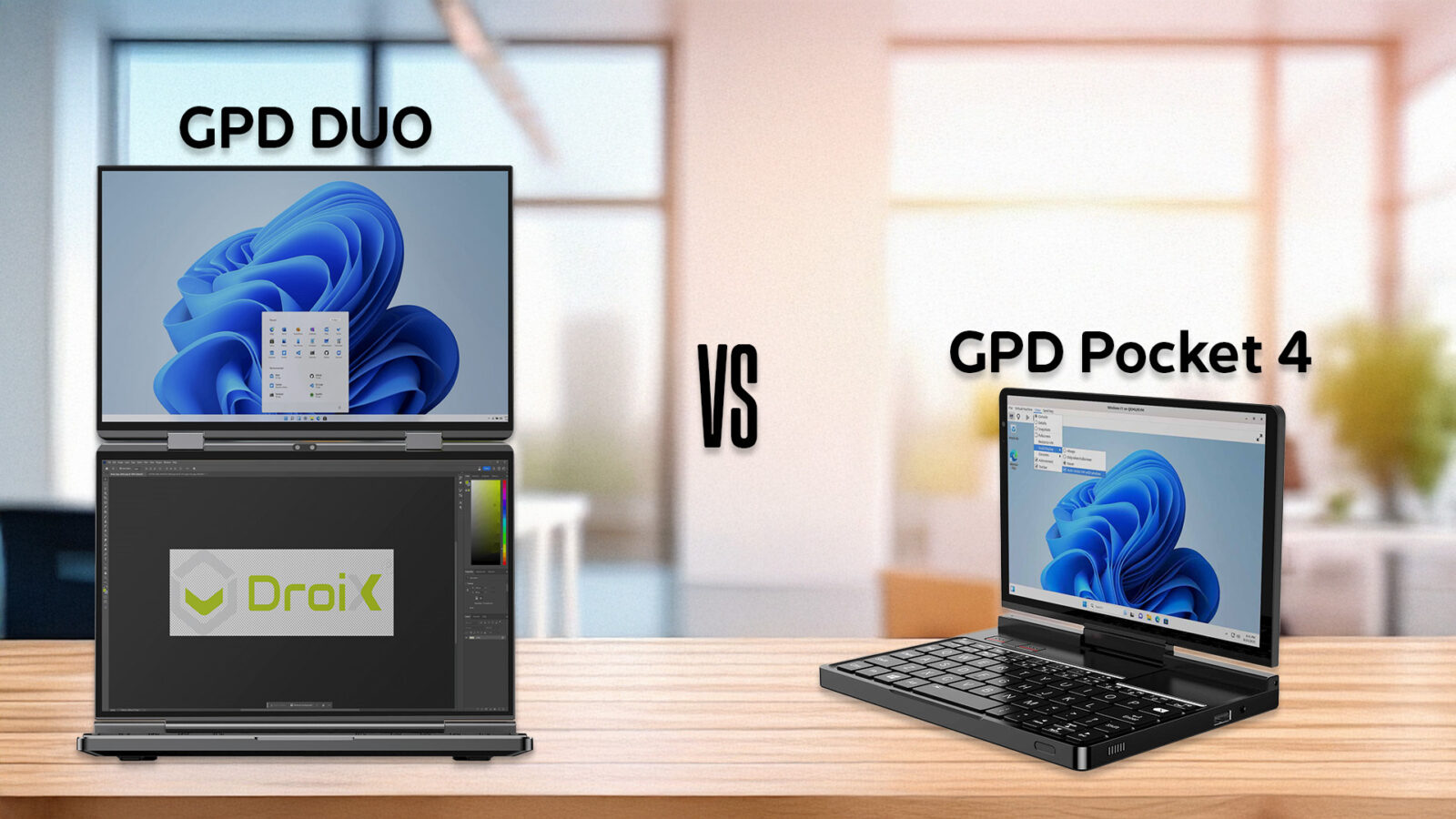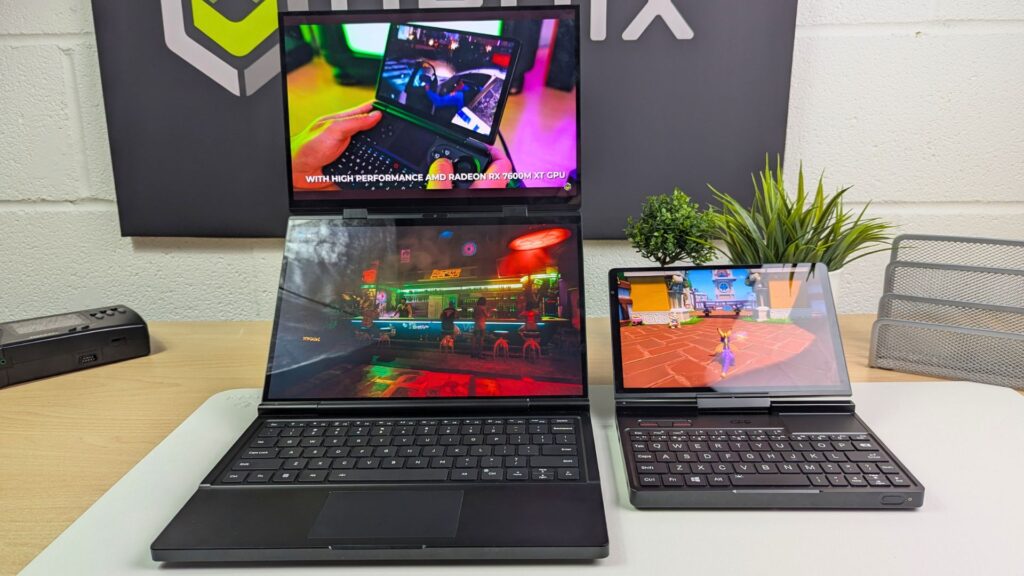Portable computing has reached new heights with the GPD Pocket 4 and GPD Duo, two devices designed to cater to the needs of professionals, students, and tech enthusiasts. These devices combine high performance with innovative designs in ultra-portable packages. But which one is better suited for your needs? In this comprehensive GPD Pocket 4 vs GPD Duo comparison, we’ll explore their strengths and ideal uses in productivity, creativity, work, and leisure to help you make an informed choice.
Size and Weight: Compact Portability Compared
Portability is a major factor for users who rely on their devices for work and leisure. The GPD Pocket 4 is a small-sized laptop, measuring 8.14 x 5.6 x 0.87 inches (20.68 × 14.45 × 2.22 cm) and weighing 785g (1.7 lbs). It’s slightly larger and heavier than its predecessor, the GPD Pocket 3, but remains compact enough to fit into a small bag. This lightweight laptop is ideal for users constantly on the move, such as students needing a reliable ultra portable device for taking notes or professionals requiring a mini laptop for business meetings and travel.
The GPD Duo, on the other hand, is bulkier, owing to its dual display laptop design. Measuring at 11.6 x 8.2 x 0.9 inches (29.7 × 20.9 × 2.3 cm) and 2.27 kilos (5 lbs). While this adds some weight, the additional screen significantly enhances multitasking capabilities. Its compact form still makes it portable, but the Duo is better suited for professionals and creatives who prioritize functionality over extreme portability. Whether working on presentations or managing creative projects, the Duo strikes a balance between portability and utility.


Display: A Visual Powerhouse for Different Needs
The GPD Pocket 4 boasts an 8.8-inch touchscreen with a stunning 2560×1600 resolution and a 144Hz refresh rate. The high refresh rate ensures smooth visuals, whether you’re scrolling through documents or watching videos. Its support for a capacitive stylus does let down its use for digital artists for example, but best suited for note-takers, and students. The vibrant display is perfect for media consumption, casual gaming, or working with visually demanding applications.
In contrast, the GPD Duo delivers a unique experience with its dual screen laptop setup. The dual 13.3″ inch displays have a 2800×1800 resolution with 60Hz refresh rate. The active stylus compatibility allows creatives to sketch, annotate, or design with precision, making it an excellent choice for designers and content creators. The second screen also enhances productivity by displaying reference material, emails, or tool palettes alongside your primary work.
Both devices excel in display quality, but their strengths cater to different users. The Pocket 4 is a compact laptop optimized for immersive visuals with higher refresh rate, while the Duo is the go-to dual display laptop for multitaskers and creatives with the important active stylus support.
Design: 2-in-1 Versatility vs. Dual-Screen Innovation
The GPD Pocket 4 features a 2-in-1 laptop and tablet design, allowing users to rotate the display 180 degrees and switch seamlessly between laptop and tablet modes. This flexibility is invaluable for users who frequently shift between typing, presenting, and touch-based interactions. Whether it’s a student sketching diagrams in tablet mode or a professional delivering presentations, this ultra-portable notebook adapts to the task at hand.


The GPD Duo, by comparison, focuses on innovation with its dual screen laptop design. The second display transforms workflows, enabling users to manage complex tasks with greater efficiency. For example, video editors can keep their timeline on the secondary screen while previewing their project on the primary display. Similarly, coders and writers benefit from having reference material or notes visible alongside their main work. The displays can be folded down to a tablet style design, but the weight is considerably heavier than the GPD Pocket 4 which could be a factor when holding it for long periods of time.
Keyboard: Usability in Any Scenario
The GPD Pocket 4 offers a smaller but highly functional chiclet keyboard. Its backlit keys are well-spaced and responsive, making it suitable for extended typing sessions despite its compact size. This keyboard is an excellent fit for students writing essays, professionals drafting reports, or anyone needing a lightweight laptop for on-the-go productivity. Its tactile feedback ensures comfort even during long hours of use.
Meanwhile, the GPD Duo features a full-size laptop keyboard, delivering a typing experience closer to traditional laptops. The larger key spacing and layout make it ideal for users who work extensively with text, such as writers, editors, or business professionals. Combined with the dual-screen setup, the Duo’s keyboard enhances productivity by providing a familiar and efficient input method for multitasking-heavy workflows.
GPD Pocket 4 vs GPD Duo Technical Specifications
| GPD DUO | GPD POCKET 4 | |
| CPU | Ryzen 7 8840U Ryzen AI 9 HX 370 | Ryzen 7 8840U Ryzen AI 9 HX 365 Ryzen AI 9 HX 370 |
| GPU | (8840U) AMD Radeon 780M (HX 370) AMD Radeon 890M | (8840U) AMD Radeon 780M (HX 365) AMD Radeon 880M (HX 370) AMD Radeon 890M |
| RAM | 32GB, 64GB LPDDR5X 7500 MT/s | 16GB, 32GB, 64GB LPDDR5X 7500 MT/s |
| STORAGE | 1TB, 2TB, 4TB, 8TB NVMe PCI-E Gen 4.0 | 1TB, 2TB, 4TB NVMe PCI-E Gen 4.0 |
| COMMUNICATIONS | Wi-Fi 6E Bluetooth 5.3 2.5 Gbps Ethernet | Wi-Fi 6E Bluetooth 5.3 2.5 Gbps Ethernet |
| DISPLAY | 2x 13.3″, 2880×1800, 60Hz, 255 PPI | 8.8″, 2560×1600, 144Hz, 343 PPI, 500 nits |
| I/O | 1x USB 4.0 Type-C 1x USB Type-C 2x USB Type-A 3.2 Gen 2 | 1x USB 4.0 Type-C, 1x USB Type-C 1x USB Type-A 2.0 1x USB Type-A 3.2 Gen 2 |
| BATTERY | 80Wh Li-po | 44.8Wh Li-po |
| BUY | HERE | HERE |
Performance: Power Tailored to Your Needs
Please note the following benchmarks and comparisons were performed on pre-production models of GPD Pocket 4 and GPD Duo. There may be some differences in performance, we do expect them to be potentially improved by the time the consumer model is released due to optimised drivers. We will retest both once the final models are available.
PCMARK
The GPD Duo has a small advantage here over the Pocket 4, nothing large enough to be worried about.
GEEKBENCH 6
We got very close scores for both devices on Geekbench 6 which is great to see.
Cinebench 2024
We see a noticeably higher score on multi-core performance for the GPD Duo.
3DMARK
For the three benchmarks tests we run with 3DMark we can see in Time Spy and Night Raid slightly different scores between the two models. And almost the same score for Fire Strike.
Battery Life, Fan Noise, and Thermals
Both the GPD Pocket 4 and Duo were using pre-production models when running the below battery life, fan noise and temperature tests. We will re-run and revise these results when the final consumer models are available. The tests were performed while running Cinebench on a loop, full brightness at 28W TDP.
The GPD Pocket 4 has a 45W battery which in our tests lasted 1 hour 1 minute. Average usage will get you around 5 hours. While idle on the desktop we got a barely audible 45dB and under full load 67dB. We measured an average of around 49 °C average temperature. It is worth noting the fan curve is overly high in the pre-production model, and should be lower by the time it is released to consumers.


The GPD Duo offers improved battery performance thanks to the larger 80Wh battery, though the additional screen draws slightly more power during multitasking. We got around 1 hour 45 with both displays and around 2 hours 15 minutes with one display in use. Average usage will of course be higher, around 6-7 hours. Its fans operate quieter than the Pocket 4’s at around 55dB during average usage. We measured an average of around 50 °C average temperature.
Ports and Connectivity: Modular Versatility vs. Standard Simplicity
Both models have all the usual ports including USB 4, USB Type-c, USB-A, HDMI and a 3.5mm audio jack.
The GPD Pocket 4 takes the lead in connectivity with its innovative modular port system. This feature allows users to swap between modules like a 4G LTE module, KVM module or RS-232 module, making it a true industry mini laptop for specialized tasks. Learn more about the modular port here.
The GPD Duo, while lacking modular options, caters to users who don’t require specialized ports but value straightforward access to peripherals. But, unlike the Pocket 4, it does have an OCuLink port which enables higher speed data connections compared to the USB 4 port. This enables faster performance with devices such as the GPD G1 eGPU docking station. The Duo’s focus on usability aligns well with its role as a dual screen laptop for business and creative professionals.
AI Capabilities and Graphics Performance
Both the GPD Pocket 4 and GP Duo are powered by the AMD Ryzen AI 9 HX 370 processor, featuring advanced XDNA 2 technology. This cutting-edge processor enables sophisticated machine learning, real-time data processing, and intelligent automation capabilities. Key benefits include optimized productivity through AI-enhanced workflows, support for large AI models with up to 16GB of GPU-dedicated memory, seamless compatibility with modern AI applications and development platforms, and the ability to perform on-device AI processing, reducing dependency on cloud-based solutions.
When combined with the optional GPD G1 eGPU docking station, the total AI performance reaches an impressive 108 TOPS, dramatically boosting its ability to handle resource-intensive AI tasks. The additional processing power provided by the GPD G1 accessory significantly elevates the both models capabilities, establishing it as a standout choice for AI-driven applications within its category.
While both models are not gaming laptops they are more than powerful enough to run the latest games at reasonable settings for this processor and graphics type. For Forza Horizon 5 the graphics are on the Very Low settings for benchmarking but you can run it as high as 1080P High graphics with FSR enabled for 60+ FPS.
External Monitor Support
For users needing external displays, both the GPD Duo and GPD Pocket 4 supports up to three monitors via its HDMI and two USB-C ports. This capability is invaluable for professionals managing multiple tasks or large data sets. The GPD Duo does have the advantage of the built-in second display bringing it up to a total of 5 displays. Or you could use the GPD G1 for more displays if required!


Summary: Which Should You Choose?
Choosing between the GPD Pocket 4 vs GPD Duo depends on your priorities. The GPD Pocket 4, with its high 114Hz refresh rate and modular port, is perfect for industry professionals, students, and those in need of a versatile ultra-portable notebook. If you would like to learn more about it, read our full GPD Pocket 4 review here.



Meanwhile, the GPD Duo, with its dual screens, full size keyboard and active stylus support leans towards a design and multitasking focus, it is ideal for creatives, educators, and productivity enthusiasts. If you would like to learn more about it, read our full GPD Duo review here.
Where to buy the GPD Duo and GPD Pocket 4?
You can learn more and buy the GPD Pocket Duo here, and buy the GPD Pocket 4 here. All GPD devices come with a two year warranty with DROIX.
Conclusion: Let Us Know Your Choice
Both devices bring unique strengths to the table. The GPD Pocket 4 vs GPD Duo debate ultimately comes down to your specific needs. Which one do you think suits your lifestyle best? Share your thoughts in the comments below, and let us know how you plan to use your next mini laptop!





















